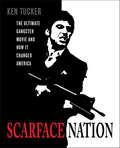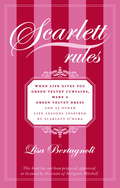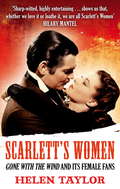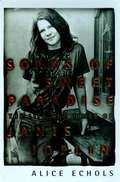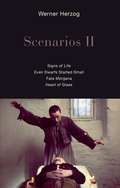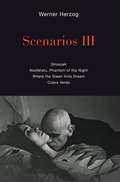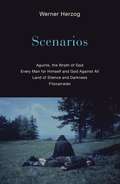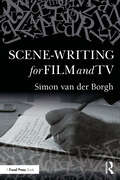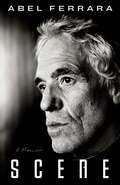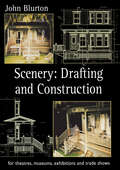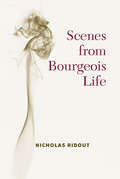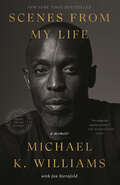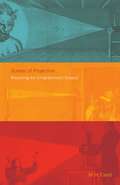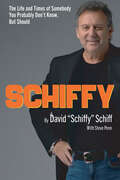- Table View
- List View
Scarface Nation: The Ultimate Gangster Movie and How It Changed America
by Ken Tucker"Don't get high on your own supply."Brian de Palma's brash, bloody version of Scarface was trashed by critics when it came out twenty-five years ago and didn't do well at the box office, but has become a spectacular fan favorite and enduring pop culture classic since."Never underestimate the greed of the other guy."What makes millions of people obsess over this movie? Why has Al Pacino's Tony Montana become the drug kingpin whose pugnacity and philosophy are revered in boardrooms and bedrooms across America? Who were the people that made the movie, influencing hip-hop style and swagger to this day?"The world is yours."Scarface Nation is Ken Tucker's homage to all things Scarface—from the stars that acted in it to the influence it's had on all of us, from facts, figures and stories about the making of the movie to a witty and comprehensive look at Scarface's traces in today's pop and political culture."Say hello to my li'l fren!"You know you love the line. You know you've seen the movie more than once. Now dive into the ultimate book of Scarface—mounded as high as the pile of cocaine on Tony's desk with delicious details and stimulating observations."You know what capitalism is? F--- you!"
Scarlett O'Hara's Younger Sister
by Evelyn KeyesThis story of a movie star by the star herself is vulgar, very real, very innocent by turns, with her views on Fredric March, Artie Shaw, John Huston, Kirk Douglas, Mike Todd and many more.
Scarlett Rules: When Life Gives You Green Velvet Curtains, Make a Green Velvet Dress
by Lisa Bertagnoli"Some day I'm going to do and say everything I want to do and say, and if people don't like it I don't care. "-Scarlett O'Hara, from Gone with the Wind Ever since the publication of Margaret Mitchell's 1936 epic blockbuster, Gone with the Wind, Scarlett O' Hara has captivated millions with her wily ways, saucy attitude, irresistible charms-and legendary faults. Now, in Scarlett Rules, intrepid journalist Lisa Bertagnoli shares 24 life-enhancing lessons inspired by Tara's most beguiling resident. Rule 1: Pretty Is as Pretty Does-Not a conventional beauty, the literary Scarlett knew it took more than an attractive face to get noticed. Learn to put your best features forward. Rule 8: Keep Your Eyes on the Prize-Scarlett used determination and perseverance to survive and thrive. Unlock your abilities and go for the gold. Rule 15: Find Your Niche-A woman ahead of her time, Scarlett succeeded on her strengths. Discover your gift and shine! With each pearl of wisdom comes a Scarlett Lesson featuring savvy advice from life coaches, relationship gurus, and other experts. Full of wit and insight, this irresistible guide guarantees that, as God is your witness, you'll never be without gumption, poise, and individual style again!
Scarlett's Women: 'Gone With the Wind' and its Female Fans
by Helen TaylorOne of the most successful books ever published and the basis of one of the most popular and highly praised Hollywood films of all time, Gone With the Wind has entered world culture in a way that few other stories have. Seventy-five years on from the cinematic release of Gone with the Wind, Helen Taylor looks at the reasons why the book and film have had such an appeal, especially for women. Drawing on letters and questionnaires from female fans, she brings together material from southern history, literature, film and feminist theory and discusses the themes of the Civil War and issues of race. She has previously written Gender, Race and Region in the writings of Grace King, Ruth McEnery Stuart and Kate Chopin and The Daphne Du Maurier Companion.culture and the reasons why Gone With the Wind maintains a special place in female hearts. 'fascinating . . . an original original' Suzy Feay, Time Out
Scarlett's Women: 'Gone With the Wind' and its Female Fans
by Helen TaylorOne of the most successful books ever published and the basis of one of the most popular and highly praised Hollywood films of all time, Gone With the Wind has entered world culture in a way that few other stories have.Seventy-five years on from the cinematic release of Gone with the Wind, Helen Taylor looks at the reasons why the book and film have had such an appeal, especially for women. Drawing on letters and questionnaires from female fans, she brings together material from southern history, literature, film and feminist theory and discusses the themes of the Civil War and issues of race. She has previously written Gender, Race and Region in the writings of Grace King, Ruth McEnery Stuart and Kate Chopin and The Daphne Du Maurier Companion.
Scars of Sweet Paradise: The Life and Times of Janis Joplin
by Alice EcholsJanis Joplin was the skyrocket chick of the sixties, the woman who broke into the boys' club of rock and out of the stifling good-girl femininity of postwar America. With her incredible wall-of-sound vocals, Joplin was the voice of a generation.
Scars of Sweet Paradise: The Life and Times of Janis Joplin
by Alice EcholsJanis Joplin was the skyrocket chick of the sixties, the woman who broke into the boys' club of rock and out of the stifling good-girl femininity of postwar America. With her incredible wall-of-sound vocals, Joplin was the voice of a generation, and when she OD'd on heroin in October 1970, a generation's dreams crashed and burned with her. Alice Echols pushes past the legary Joplin-the red-hot mama of her own invention-as well as the familiar portrait of the screwed-up star victimized by the era she symbolized, to examine the roots of Joplin's muscianship and explore a generation's experiment with high-risk living and the terrible price it exacted.A deeply affecting biography of one of America's most brilliant and tormented stars, Scars of Sweet Paradise is also a vivid and incisive cultural history of an era that changed the world for us all.
Scattershot: Life, Music, Elton, and Me
by Bernie Taupin**NEW YORK TIMES BESTSELLER** An evocative, clear-eyed, and revealing memoir by Bernie Taupin, the lyrical master and long-time collaborator of Elton John&“I loved writing, I loved chronicling life and every moment I was cogent, sober, or blitzed, I was forever feeding off my surroundings, making copious notes as ammunition for future compositions. . . . The thing is good, bad, or indifferent I never stopped writing, it was as addictive as any drug.&” This is the memoir music fans have been waiting for. Half of one of the greatest creative partnerships in popular music, Bernie Taupin is the man who wrote the lyrics for Elton John, who conceived the ideas that spawned countless hits, and sold millions and millions of records. Together, they were a duo, a unit, an immovable object. Their extraordinary, half-century-and-counting creative relationship has been chronicled in biopics (like 2019's Rocketman) and even John's own autobiography, Me. But Taupin, a famously private person, has kept his own account of their adventures close to his chest, until now. Written with honesty and candor, Scattershot allows the reader to witness events unfolding from Taupin's singular perspective, sometimes front and center, sometimes from the edge, yet always described vibrantly, with an infectious energy that only a vivid songwriter's prose could offer. From his childhood in the East Midlands of England whose imagination was sparked and forever informed by the distinctly American mythopoetics of country music and cowboy culture, to the glittering, star-studded fishbowl of &’70s and &’80s Beverly Hills, Scattershot is simultaneously a Tom Jones-like picaresque journey across a landscape of unforgettable characters, as well as a striking, first-hand account of a creative era like no other and one man&’s experience at the core of it. An exciting, multi-decade whirlwind told in a non-linear yet grounded narrative, Scattershot whizzes around the world as we ride shotgun with Bernie on his extraordinary life. We visit Los Angeles with him and Elton on the cusp of global fame. We spend time with him in Australia almost in residency at an infamous rock 'n' roll hotel in an endless blizzard of drugs. And we spend late, late night hours with John Lennon, with Bob Marley, and hanging with Frank Sinatra. And beyond the world of popular music, we witness memorable encounters with writers like Graham Greene, painters like Andy Warhol and Salvador Dali, and scores of notable misfits, miscreants, eccentrics, and geniuses, known and unknown. Even if they're not famous in their own right, they are stars on the page, and we discover how they inspired the indelible lyrics to songs such as &“Tiny Dancer,&” &“Candle in the Wind,&” &“Bennie and The Jets,&” and so many more. Unique and utterly compelling, Scattershot will transport the reader across the decades and around the globe, along the way meeting some of the greatest creative minds of the 20th century, and into the vivid imaginings of one of music's most legendary lyricists.
Scenarios II: Signs of Life; Even Dwarfs Started Small; Fata Morgana; Heart of Glass
by Werner HerzogThe second in a series: the master filmmaker&’s prose scenarios for four of his notable filmsOn the first day of editing Fata Morgana, Werner Herzog recalls, his editor said: &“With this kind of material we have to pretend to invent cinema.&” And this, Herzog says, is what he tries to do every day. In this second volume of his scenarios, the peerless filmmaker&’s genius for invention is on clear display. Written in Herzog&’s signature fashion—more prose poem than screenplay, transcribing the vision unfolding before him as if in a dream—the four scenarios here (three never before translated into English) reveal an iconoclastic craftsman at the height of his powers.Along with his template for the film poem Fata Morgana (1971), this volume includes the scenarios for Herzog&’s first two feature films, Signs of Life (1968) and Even Dwarfs Started Small (1970), along with the hypnotic Heart of Glass (1976). In a brief introduction, Herzog describes the circumstances surrounding each scenario, inviting readers into the mysterious process whereby one man&’s vision becomes every viewer&’s waking dream.
Scenarios III: Stroszek; Nosferatu, Phantom of the Night; Where the Green Ants Dream; Cobra Verde
by Werner HerzogFor the first time in English, and in his signature prose poetry, the film scripts of four of Werner Herzog&’s early works &“Herzog doesn&’t write traditional scripts,&” Film International remarked of the master filmmaker&’s Scenarios I and II. &“Instead, he writes scenarios which are like a hybrid of film, fiction, and prose poetry.&”Continuing a series that Publishers Weekly pronounced &“compulsively readable . . . equal parts challenging and satisfying, infuriating and enlightening,&” Scenarios III presents, for the first time in English, the shape-shifting scripts for four of Werner Herzog&’s early films: Stroszek; Nosferatu, Phantom of the Night; Where the Green Ants Dream; and Cobra Verde. We can observe Herzog&’s working vision as each of these scenarios unfolds in a form often dramatically different from the film&’s final version—as, in his own words, Herzog works himself up into &“this kind of frenzy of high-caliber language and concepts and beauty.&”With Scenarios I and II, this volume completes the picture of Herzog&’s earliest work, affording a view of the filmmaker mastering his craft, well on his way to becoming one of the most original, and most celebrated, artists in his field.
Scenarios: Aguirre, the Wrath of God; Every Man for Himself and God Against All; Land of Silence and Darkness; Fitzcarraldo
by Werner HerzogI do not follow ideas, I stumble into stories or into people; and I know that this is so big, I have to make a film. Very often, films come like uninvited guests, like burglars in the middle of the night. They are in your kitchen; something is stirring, you wake up at 3 a.m. and all of a sudden they come wildly swinging at you.When I write a screenplay, I write it as if I have the whole film in front of my eyes. Then it is very easy for me, and I can write very, very fast. It is almost like copying. But of course sometimes I push myself; I read myself into a frenzy of poetry, reading Chinese poets of the eighth and ninth century, reading old Icelandic poetry, reading some of the finest German poets like Hölderlin. All of this has absolutely nothing to do with the idea of my film, but I work myself up into this kind of frenzy of high-caliber language and concepts and beauty.And then sometimes I push myself by playing music, for example, a piano concerto by Beethoven, and I play it and write furiously. But none of this is an answer to the question of how you focus on a single idea for a film. And then, during shooting, you have to depart from it sometimes, while keeping it alive in its essence. —Werner Herzog, on filmmakingWerner Herzog doesn&’t write traditional screenplays. He writes fever dreams brimming with madness, greed, humor, and dark isolation that can shift dramatically during production—and have materialized into extraordinary masterpieces unlike anything in film today. Harnessing his vision and transcendent reality, these four pieces of long-form prose earmark a renowned filmmaker at the dawn of his career.
Scene-writing for Film and TV
by Simon van der BorghFocusing on an integral aspect of screenplays, this book takes students and writers at all levels through the process of understanding and writing better scenes. It interrogates the functions of a scene and how writers can then apply this knowledge to their own film and television scripts. Author Simon van der Borgh familiarises the screenwriter with the fundamental aspects of a scene, looking at what a scene is, the characters involved, the action depicted, dialogue, setting, and style. Featuring original scenes which show the practice of scene-writing and the application of ideas and approaches alongside in-depth analysis and critique, the book explores the process and approach to scene-writing and how to learn and improve methods of telling dynamic, engaging and moving stories of diverse types and formats on screen. With a strong focus on practice-based advice, the book includes exercises at every step to enable writers to build on and extend their knowledge and skills with confidence and clarity chapter by chapter. Exploring the film and TV scene with its different types, forms, and functions, it is the ideal book for aspiring screenwriters and students of screenwriting and filmmaking at all levels, as well as directors, producers and actors looking to better understand the contextual and sub-textual motivations intended by the writer.
Scene: A Memoir
by Abel FerraraA kaleidoscopic memoir by acclaimed filmmaker Abel Ferrara, director of the cult classic films Bad Lieutenant, King of New York, and Dangerous Game, offering an unflinching look at his life, career, and the gritty world of independent cinema.Throughout his five-decade career, film director Abel Ferrara—now in his seventies—has been one of cinema&’s most provocative and critically revered figures. Since beginning as an independent filmmaker in Manhattan in the early 1970s—before &“indie films&” were a genre—and refining his craft as a director for the TV show Miami Vice, he has directed more than thirty feature films, most notably the cult classics Bad Lieutenant, King of New York, and Dangerous Game. His work, often controversial for its depictions of sex, violence, and drugs, has been praised for its sincerity and depth, with critics noting that his films take spirituality and morality more seriously than most films do. In Scene, Ferrara opens up about the inspiration for his creativity detailing his dramatic life journey, from his rough upbringing in the 1950s Bronx to reaching the pinnacle of his career while struggling with addiction. This memoir is not just a recounting of his life but a manifesto on what it means to be a true artist—one who refuses to compromise and continues to create boundary-pushing work. Scene is a profound, beautiful, and inspiring account of an artist&’s relentless pursuit of creativity, making it a must-read for film fans and anyone interested in the gritty realities of the entertainment industry.
Scenery: Draughting and Construction for Theatres, Museums, Exhibitions and Trade Shows
by John BlurtonThis practical book looks at the types of drawing used, equipment, materials commonly specified, surveying, and also covers building floors, flats, cloths, windows, doors, trucks, staircases, roofs, revolves, multi-story structures, and bridges. By addressing both theater and the commercial world this book will be of real help to a broad range of people in the theater industry.
Scenes and Monologs from the Best New Plays: An Anthology of New Dramatic Writing from Professionally Produced American Plays
by Roger EllisThis book is a practical resource for acting and directing students of all ages middle through high school, college, and professionals young and old. Its 30 duet scenes and eight monologues include a fair sampling of the late 20th-century work of playwrights across the United States. These excerpts are highly original in that few people can claim to have read or seen them performed, though they have all been produced regionally. The gallery of characters contained in these pages offers readers an arresting and kaleidoscopic reflection of American society. The literary styles one encounters here demonstrate the range and power of American writers who will continue to shape theatrical techniques for years to come. Overall, this anthology provides a generous sampling of vital and compelling treatments of our social, artistic, and spiritual experiences of the late 20th century.
Scenes from Bourgeois Life (Theater: Theory/Text/Performance)
by Nicholas RidoutScenes from Bourgeois Life proposes that theatre spectatorship has made a significant contribution to the historical development of a distinctive bourgeois sensibility, characterized by the cultivation of distance. In Nicholas Ridout’s formulation, this distance is produced and maintained at two different scales. First is the distance of the colonial relation, not just in miles between Jamaica and London, but also the social, economic, and psychological distances involved in that relation. The second is the distance of spectatorship, not only of the modern theatregoer as consumer, but the larger and pervasive disposition to observe, comment, and sit in judgment, which becomes characteristic of the bourgeois relation to the rest of the world. This engagingly written study of history, class, and spectatorship offers compelling proof of “why theater matters,” and demonstrates the importance of examining the question historically.
Scenes from My Life: A Memoir
by Jon Sternfeld Michael K. WilliamsA moving, unflinching memoir of hard-won success, struggles with addiction, and a lifelong mission to give back—from the late iconic actor beloved for his roles in The Wire, Boardwalk Empire, and Lovecraft CountryWhen Michael K. Williams died on September 6, 2021, he left behind a career as one of the most electrifying actors of his generation. From his star turn as Omar Little in The Wire to Chalky White in Boardwalk Empire to Emmy-nominated roles in HBO&’s The Night Of and Lovecraft Country, Williams inhabited a slew of indelible roles that he portrayed with a rawness and vulnerability that leapt off the screen. Beyond the nominations and acclaim, Williams played characters who connected, whose humanity couldn&’t be denied, whose stories were too often left out of the main narrative.At the time of his death, Williams had nearly finished a memoir that tells the story of his past while looking to the future, a book that merges his life and his life&’s work. Mike, as his friends knew him, was so much more than an actor. In Scenes from My Life, he traces his life in whole, from his childhood in East Flatbush and his early years as a dancer to his battles with addiction and the bar fight that left his face with his distinguishing scar. He was a committed Brooklyn resident and activist who dedicated his life to working with social justice organizations and his community, especially in helping at-risk youth find their voice and carve out their future. Williams worked to keep the spotlight on those he fought for and with, whom he believed in with his whole heart.Imbued with poignance and raw honesty, Scenes from My Life is the story of a performer who gave his all to everything he did—in his own voice, in his own words, as only he could.
Scenes of Projection: Recasting the Enlightenment Subject
by Jill H. CasidTheorizing vision and power at the intersections of the histories of psychoanalysis, media, scientific method, and colonization, Scenes of Projection poaches the prized instruments at the heart of the so-called scientific revolution: the projecting telescope, camera obscura, magic lantern, solar microscope, and prism. From the beginnings of what is retrospectively enshrined as the origins of the Enlightenment and in the wake of colonization, the scene of projection has functioned as a contraption for creating a fantasy subject of discarnate vision for the exercise of &“reason.&” Jill H. Casid demonstrates across a range of sites that the scene of projection is neither a static diagram of power nor a fixed architecture but rather a pedagogical setup that operates as an influencing machine of persistent training. Thinking with queer and feminist art projects that take up old devices for casting an image to reorient this apparatus of power that produces its subject, Scenes of Projection offers a set of theses on the possibilities for felt embodiment out of the damaged and difficult pasts that haunt our present.
Schau-Prozesse: Gericht und Theater als Bühnen des Politischen (Literatur und Recht #8)
by Stefan Arnold Kerstin WilhelmsGerichtsprozesse wie der NSU-Prozess haben große mediale Aufmerksamkeit erfahren und sind zum Stoff von zahlreichen Theaterinszenierungen geworden. Solche publikumswirksamen ‚Schau-Prozesse‘ zeigen, wie Gericht und Theater zu Bühnen des Politischen werden. Dabei wird deutlich, dass Recht und Theater viel fundamentaler verbunden sind, als bislang diskutiert: Sie konstituieren sich gegenseitig. Theatrale Elemente sind für das Recht unverzichtbar und umgekehrt prägen Rechtsinszenierungen das Theater. Die Beiträge des interdisziplinären Bandes analysieren diese Wechselseitigkeit und fokussieren die politische Performance im Theater und im Recht.
Scheduling and Budgeting Your Film: A Panic-Free Guide (American Film Market Presents)
by Paula LandryBudgeting and scheduling are easy in principle but hard in practice. The successful producer has a solid plan for juggling dozens of activities and costs while retaining the flexibility to cope with those inevitable last-minute changes and stay on course. Preplanning the budget and schedule of any media project is absolutely essential, and the 2nd edition of Scheduling and Budgeting Your Film: A Panic-Free Guide shows you the intricacies of handling both budgeting and scheduling successfully. This new and updated edition explains the fundamentals of line producing in an easy-to-understand style, and includes tips and techniques that apply no matter what kind of scheduling or budgeting software you’re using. Author Paula Landry includes detailed examples of breakdown forms, organizing resources, distribution expenses, and hidden costs, and discusses how to set realistic priorities and find industry and state tax incentives. The new edition also includes discussions of transmedia and multi-purpose shooting, special considerations for VR, 4K and 3D shooting, new web platforms and mobile technology, crowd funding, film festivals, and much more. Each chapter is filled with handy checklists, tips, practical advice, and anecdotes, showing how scheduling and budgeting are done in the real world; Principles apply to any type of media project: film, video, music video, projects hosted online, and corporate and educational videos; An accompanying eResources page offers downloadable forms and templates, and other essential resources.
Schiffy - The Life and Times of Somebody You Probably Don't Know, But Should
by David SchiffSchiffy - The Life and Times of Somebody You Probably Don't Know, But Should is the story of David "Schiffy" Schiff, an internationally recognized as the go-to Orals Coach for some of the world's largest companies and has helped them win billions of dollars by securing highly lucrative government and defense contracts. Schiffy has successfully leveraged his four Emmy Awards for directing to help people tell their stories in a profound and differentiating way. Along the way he has won hundreds of international awards for excellence in his video production work, music, and event management. Schiffy knows he is only as good as the people he surrounds himself with. Whether working with a senior defense official, a CEO, a high-level Subject Matter Expert, or an actor, Schiffy makes them better at what they do. When not off on an adventure, playing his drum kit or winning big-money contracts, Schiffy is dedicated to helping a variety of charities and foundations with his generosity and passion. A note from the author: It is my sincere hope you will find value beyond the stories I tell here. We all have stories to tell. Are mine more interesting than most? I will leave it to you to decide, but I want you to remember one thing as you read the stories we lay out here: I have never had a plan for my life, I have let my life guide me, and have tried to seize the opportunities which came my way time after time - seemingly out of nowhere. More than anything, I want to convey in these pages that our lives bring us gifts which arrive to shape us and our future in ways we least expect. They mold our character and move us forward in directions we never could have imagined. I hope you like the ones I share with you in this book. Not because I'm a famous guy. But because I met those challenges, took those chances and made my life immensely richer for it.
Schindler's List (SparkNotes Film Guide)
by SparkNotesSchindler's List (SparkNotes Film Guide) Making the reading experience fun! SparkNotes Film Guides are one-stop guides to great works of film–masterpieces that are the foundations of filmmaking and film studies. Inside each guide you&’ll find thorough, insightful overviews of films from a variety of genres, styles, and time periods. Each film guide contains:Information about the director and the context in which the film was made Thoughtful analysis of major characters Details about themes, motifs, and symbols Explanations of the most important lines of dialogue In-depth discussions about what makes a film so remarkable SparkNotes Film Guides are an invaluable resource for students or anyone who wants to gain a deeper understanding of the great films they know and love.
Schlock Value: Hollywood at Its Worst
by Richard RoeperA hilarious collection of essays, riffs, and lists that celebrate the insanity of Hollywood--for anyone who loves the movies. Richard Roeper, like the rest of us, adores the movies. In this uproarious, off-beat book, he gives us a whole new set of critical lenses for assessing the movies and the people and the industry that make them. With his characteristic acerbic wit, he weaves short essays with lists that work together to explain where Hollywood succeeds--and where it so often frustrates, disappoints, and fails us. But while Roeper devotes most of the book to mockery and ridicule, this book is, in the end, a love letter to film. Some of the essays and lists included in Schlock Value: Comical statistical breakdowns, including career batting averages of actors Reviews of Hollywood finances, including budgets, salaries, and ticket prices A proposed moratorium on pet projects, e.g., Kevin Costner's The Postman or John Travolta's Battlefield Earth The age differences between Woody Allen and his various leading ladies Actors appearing around the world in television commercials, including a list of the biggest stars that do overseas commercials--and the products they push Schlock Value is the perfect book for anyone who loves grumbling and complaining about the movies--but still can't help spending their weekends and evenings in front of the screen.
Schlüsselwerke der Medienwissenschaft
by Ivo RitzerDer Band stellt ausgewählte Positionen und zentrale Ideen im disziplinären Rahmen der Medienwissenschaft vor. Schwerpunkte liegen auf medienphilosophischen Ansätzen und einer kulturtheoretischen Perspektive, die sich vor einem dezidiert geisteswissenschaftlichen Horizont konturiert. Dabei versteht der Band sich nicht nur als Handbuch und Nachschlagewerk für Studierende wie Lehrende, er soll vielmehr auch einen eigenen Beitrag zur medienwissenschaftlichen Theoriebildung leisten.
Schoenberg and Hollywood Modernism
by Kenneth H. MarcusSchoenberg is often viewed as an isolated composer who was ill-at-ease in exile. In this book Kenneth H. Marcus shows that in fact Schoenberg's connections to Hollywood ran deep, and most of the composer's exile compositions had some connection to the cultural and intellectual environment in which he found himself. He was friends with numerous successful film industry figures, including George Gershwin, Oscar Levant, David Raksin and Alfred Newman, and each contributed to the composer's life and work in different ways: helping him to obtain students, making recordings of his music, and arranging commissions. While teaching at both the University of Southern California and the University of California, Los Angeles, Schoenberg was able to bridge two utterly different worlds: the film industry and the academy. Marcus shows that alongside Schoenberg's vital impact upon Southern California Modernism through his pedagogy, compositions and texts, he also taught students who became central to American musical modernism, including John Cage and Lou Harrison.
